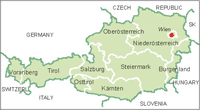
Settlements
 Klagenfurt, (1991 pop. 89,415), capital of Carinthia province, S Austria, on the Glan River. Situated in a mountain lake region, it is a noted winter sports center with a bustling tourist trade. Manufactures include electrical apparatus, clothing, shoes, tobacco, wood, products, and leather goods. The city also has industries in metal, processed food, and chemicals. An annual timber fair is held there. Klagenfurt was chartered about the mid-13th cent. and became an episcopal see in the late 18th cent. The city has a cathedral (16th cent.), a theological seminary, and several museums.
Klagenfurt, (1991 pop. 89,415), capital of Carinthia province, S Austria, on the Glan River. Situated in a mountain lake region, it is a noted winter sports center with a bustling tourist trade. Manufactures include electrical apparatus, clothing, shoes, tobacco, wood, products, and leather goods. The city also has industries in metal, processed food, and chemicals. An annual timber fair is held there. Klagenfurt was chartered about the mid-13th cent. and became an episcopal see in the late 18th cent. The city has a cathedral (16th cent.), a theological seminary, and several museums.
Villach: Carinthia′s Spiritual Capital
Carinthia′s capital Klagenfurt might be a tad bigger than Villach in terms of population, but in terms of atmosphere and things to do, Villach wins the competition. A town ever since Roman times, it became an important centre of trade in the Slavonic kingdom of Carantania. Later, when the Germanic descendants of Bavarian tribes settled increasingly, the significance of Villach and its surroundings were ensured due to the good connections to both the Mediterranean area and the northern parts of today′s Austria.
 If you start exploring Villach at the Hauptplatz or Main Square, you will see the many late Medieval and Renaissance courts and burgher houses that tell the story of Medieval success. Later, many of these houses got Baroque facades, but the much older core can usually be easily recognised. Most of Villach′s town centre is pedestrianised, therefore, it is quite enjoyable to explore it with a quick stroll around. Don′t miss out on the 14th century parish church St Jakob and its cemetery.
If you start exploring Villach at the Hauptplatz or Main Square, you will see the many late Medieval and Renaissance courts and burgher houses that tell the story of Medieval success. Later, many of these houses got Baroque facades, but the much older core can usually be easily recognised. Most of Villach′s town centre is pedestrianised, therefore, it is quite enjoyable to explore it with a quick stroll around. Don′t miss out on the 14th century parish church St Jakob and its cemetery.
Gurk: The Spiritual Centre of Carinthia
The small town (or rather village, with some 1,200 residents) of Gurk is situated in the scenic Gurk River Valley and surrounded by hills with meadows and woods - over-all resembling the "Sound of Music" image that many international visitors associate with Austria. The earliest written record of Gurk dates back to 831.
In terms of sightseeing, the Parish Church formerly known as Cathedral of Gurk attracts most of the tourists′ attention. The original cathedral was built in the 12th century and ranks among the most important Romanesque buildings in Austria. This ancient core is best viewed in the crypt, which is famous for its 100 pillars. Later additions include Gothic vaults and frescos, Renaissance frescoes, and Baroque interiors such as altars. One particularly important attraction is the "Gurker Fastentuch", a painted cloth from 1458.
Nearby is the community Strassburg with a castle in which the Prince Bishops of Gurk lived and from where they ruled.
 Friesach: Middle Ages in Carinthia
Friesach: Middle Ages in Carinthia
Friesach is a small Carinthian town famous for its medieval heritage, which consists alongside with some pieces of town walls and fortifications mostly an event that is annually commemorated with a festival of medieval culture. This event was an enormous tournament organised here in Friesach by the Babenberg Duke Leopold VI of Austria in 1224. Pretty much every decent knight from all over Central Europe came to Friesach on this occasion.
Spittal an der Drau
The town of Spittal an der Drau is often used by visitors as a gateway to Lake Millstatter See, which lies only four kilometres east of the town. Spittal also has a bigger tourist information centre that serves requests for the entire lake region - however, this should not keep you from having a closer look at the town itself before you head for the swimming, windsurfing and other water-sports.
The visitors come to see one of Austria′s most elaborate Renaissance castles: the centrally located Schloss Porcia Castle was built by the Spanish noble-man Gabriel of Salamanca, who served as a treasurer to the Habsburgs in the 15th century. A very wealthy man, he bought an entire county and got Italian craftsman to erect a presentable castle right in the middle of it. In 1662, the castle was sold to the Porcia family, Austrian-Italian nobility in the high rank of "Fursten" ("Princes"). They, too, were surely not struggling with a low income as one can still tell from the interiors of Schloss Porcia.
 Back to top
Back to top


 Romana
Romana English
English











